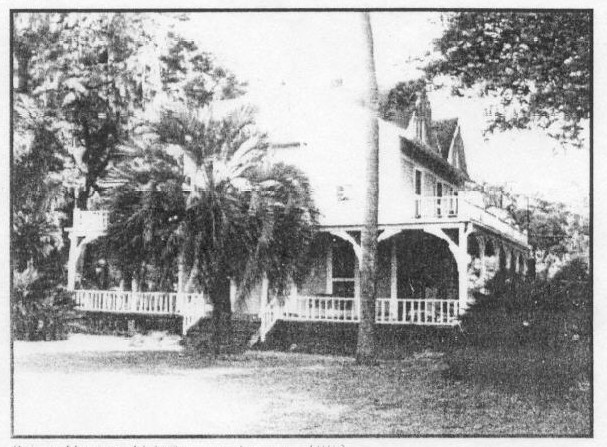
Sayre House, 414 Orange Avenue, 1883.

Arlington Bluff Store, 414 Orange Avenue, 1883

Sayre House, 414 Orange Avenue, 1883.

Arlington Bluff Store, 414 Orange Avenue, 1883
At times the northern residents who took up
homes in Florida came from the same locality. That apparently was the case
with the Hulbert and Stevens families, both of whom emigrated from Rushford,
Minnesota. Charles G. Hulbert purchased the Francis Richard home at 1300
Oak Haven Road. In 1908 Hulbert's heirs sold the property to John and Lillie
Campbell Holden whose family retained it for nearly the remainder of the
century. George and Harriet Stevens built a home on the bank of the Arlington
River. It no long stands. Mrs. Stevens and Mrs. Francis Richard were instrumental
in organizing St. Paul's Episcopal Church in what is now, South Arlington.
The original church building, constructed in 1888. was moved in 1977 and
again in 1994 to its present location in the San Marco area.
North of the Arlington River, William Matthews.
who had purchased the Sammis property, formed what he called the Arlington
Bluff Association to exploit the development plans originally launched
by the Florida Winter Home Association in 1873. The subdivision consisted
of more than twenty-six blocks, carved out in the rounded peninsula of
land that thrusts southward into the mouth of the river. It contained more
than three hundred lots facing both the St. Johns River and the Arlington
River. Promoters of the subdivision offered to build dwellings on the property
and to plant and manage citrus crops on the lands. Matthews invited "Christians
of all denominations" to join the association, predicting that the community
would become a great winter resort for the thousands who seek to escape
the rigors of northern winters. The Association even provided a steamer,
the Clifton, to carry residents back and forth to Jacksonville.
It made four trips daily to the city. The present-day subdivision derives
its name from the landing at which the steamer docked.
Matthews' residence, surrounded by an extensive
grove of orange trees he purchased from John Sammis, formed the centerpiece
of the subdivision. Steamships stopped at a dock on the St. Johns River
in front of the house to pick up fruit harvested locally. Orange Avenue
and Grove Street commemorate in name the grove that occupied the several
blocks around the house. One buyer of a lot, B. C. Sayre,
constructed two buildings on his property, one an elaborate residence,
the other an unornamented building that he converted into a general store.
His wife conducted bible studies for black and white children in the upper
floor of the store. Sayre's diary records about fifty people in attendance
at the first religious meeting. Sayre also purchased roots, berries, and
leaves, such as ginseng, vanilla leaves, and palmetto berries from local
black residents and shipped the products to pharmaceutical firms for medicinal
uses. Sayre continued to operate the Arlington Bluff Store
until his death from yellow fever in 1900. Mary Sayre survived until 1920.
An elegant Colonial Revival style house and,
nearby, a large carriage house and servants' quarters were completed about
1883 for John L. and Carrie Stewart. Their only child, Addie, inherited
the property upon their death and for a time lived alone in the 32-room
mansion, attended by numerous servants. When fortune evaporated, Addie
rented the house for a time and then sold it in 1915 to J. K. Lilly, of
the Eli Lilly family. Eventually the house passed on to one of Addie Stewart's
first boarders, Marcus C. Fagg, manager of the Children's Home Society
of Florida, one of the country's largest orphanages. The spacious Colonial
Revival style house, named Oak Lynde, and two auxiliary buildings
still stand, in fine condition, off Magnolia Bluff Avenue.

continued on jackvil9.htm ...............

